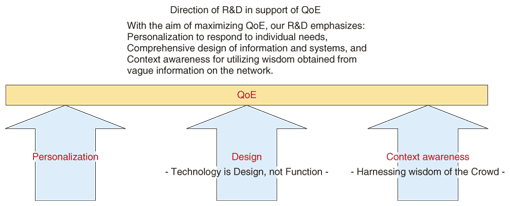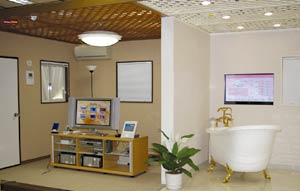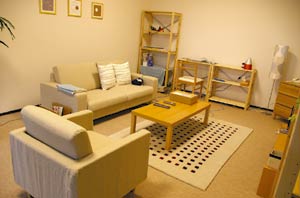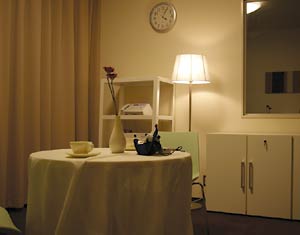Position and role of Cyber Solutions Laboratories in NTT
—Dr. Kishigami, how does Cyber Solutions Laboratories fit into the NTT organization and what is its role?
Cyber Solutions Laboratories is part of the Cyber Communications Laboratory Group. Our job has been to develop services using the audio- and video-related technologies developed by Cyber Space Laboratories in the same group and to develop services that enable anyone to access information in a user-friendly manner. In recent years, however, the expected time span for commercializing so-called Web 2.0 services and technologies has shortened considerably while, at the same time, it has become increasingly difficult to expand technologies into services. For this reason, we must always be concerned with ways of connecting R&D results to business possibilities while responding rapidly to changing times.
R&D in close proximity to the ordinary consumer
—It appears that Cyber Solutions Laboratories is focused on research emphasizing the user's point of view.
That's right. All of the areas researched at Cyber Solutions Laboratories share the concept of quality of experience (QoE). QoE expands upon the common concept of quality to mean the quality of service as seen from the user side, including such characteristics as enjoyment, ease-of-use, and operability. The concept of providing services that can be easily used by anyone of any age by maximizing QoE forms the basis of all R&D at Cyber Solutions Laboratories (Fig. 1).

Fig. 1. Concept of QoE.
—Doesn't the basic meaning of QoE differ from that of universal design?
Well, in the beginning, the catchphrase for service acceptability was quality of service, or QoS. The aim of this was to provide pleasant services on the network. Over time, however, QoS came to be used in an overly technical sense, which led to the use of QoE with the aim of reincorporating subjective evaluations from the user side into the quest for quality. Therefore, QoE is closely concerned with the user's experience, while universal design is more concerned with achieving designs that enable products or services to be used by a great number of people.
—What R&D fields are you working on?
At the moment, we are focusing on design, context awareness, and personalization.
In the area of design, we are researching not simply the appearance of hardware but also the technical aspects of software. For example, the colors commonly used on Web sites may appear normal to a visually healthy person but may be difficult to see for a person who is partially color blind. Conversely, a color that is easy for a partially color blind person to see may be difficult for a visually healthy person to appreciate. Accordingly, researching the design of colors that can be seen easily with little eye fatigue by both types of individuals, that is, by all people, as well as the design of devices that are easy to use by one and all, are major pillars of our research.
Next, in the area of context awareness, we note that a record of an individual's life activities in the form of a so-called life log would contain an immense amount of information. If we were to build up our storehouse of personal information, corporate information, and other types of information, we would no doubt make some new discoveries while, at the same time, uncover some rather useless items of information. If we could find a way to efficiently use information that in the past would normally have been thrown out, new possibilities would arise. We would have new source material at our disposal, and we would be able to automatically extract information based on past activities. At Cyber Solutions Laboratories, we are researching ways of using such information. Of course, in addition to the technical aspects of using such forms of information, we must research ways of solving privacy-related issues.
Finally, we are researching services just for you, or in other words, personalization. Today, despite the fact that we are being flooded with information, individuals and organizations cannot get their hands on the information that they really need when they need it. For example, in the area of IPTV (Internet protocol television), which we are researching and developing, we can envision several thousand if not tens of thousands of channels, which could not even be considered with the present TV. But, how is a user going to access information or programs of his or her liking from this huge number of channels? The traditional method of selecting channels using a remotely controlled tuner is hardly appropriate in this case. How, then, are we going to solve this problem and enable users to access the information that they need immediately? Using metadata techniques as a basis to work from, we are researching and developing ways of using information with metadata attached so that a user can accurately access desired information whenever needed.
—Tell us about one of the interesting technologies that your laboratories has developed.
At goo Labs. in the goo portal site for searching, we provide various next-generation-search services that our laboratories has developed. Let me introduce one of them. We worked out a blog search technology called “BLOGRANGER TG [1].” It portrays all the blogs as a virtual island. If you stroll around and explore the island, you will encounter blog articles that you are interested in just like when you wander around a book shop. We use the word explore and not search because the technology guides you to desirable information by showing you a topographic plot calculated based on metadata called tags so that you will understand the connections among blogs visually, even though you are not sure what you are looking for.
Shortening of the time span to business development
—What issues are you faced with at this time?
Physically speaking, I would say that Yokosuka, the location of Cyber Solutions Laboratories, presents a problem. While it may be ideal as a research environment, it lacks opportunities for interfacing with the outside and it is not a highly stimulating environment. If we consider the role that Cyber Solutions Laboratories plays, merely attending academic and international conferences is hardly sufficient. We must go to Tokyo and actively network with the right people. While it's true that some of this can be accomplished through videoconferencing because of work constraints, I believe that face-to-face meetings are vital to developing a good understanding of real-world trends and becoming well informed.
We are also faced with a difficult choice in terms of research. At Cyber Solutions Laboratories, a long time span of three to five years is desirable for core research. At the same time, our mission is to take one to two years in business development. Nowadays, however, the worldwide trend is to shorten the overall time span from uncovering technical possibilities to developing the technology and business applications. Because of this demand for quickly pushing research results out into the world, researchers are finding it difficult to take on long-term research. Instead, they are only pursuing research that can easily produce results. As a result, research themes themselves are becoming increasingly narrow. I'm not sure whether this is good or bad, but I myself would like to see our researchers take on research projects with as long a span as possible and to become experts in their fields.
It's natural for a business-oriented company to want to speed up business development, and, as an organization, to invest people and money in that endeavor. Originally, however, the ideal situation was to divide up management resources equally among short- and long-term research. Today, the trend is for an entire research laboratory to find ways of contributing to business in the short term, but it's my personal feeling that this has gone a bit too far.
The original role of a research laboratory was to uncover technical possibilities and pursue R&D with a view to the next phase of products or even the phase after the next one. This is why I would like to apply our efforts to core research.
Importance of knowing the consumer before commercializing new services
—Dr. Kishigami, what does the future hold for Cyber Solutions Laboratories?
We need to learn about the consumer if Cyber Solutions Laboratories is to help NTT business companies deal with their problems and provide new services. To this end, it is becoming increasingly important to research what the consumer needs and what becomes a hindrance to the consumer when we introduce new technologies. Such research should also provide valuable feedback for developing new technologies.
In addition, the personalization of information also involves difficult problems concerning privacy. For this reason, we must construct a mechanism that can provide services related to personal information without giving the user the feeling that his or her privacy has been infringed upon or any other negative impressions in relation to the use of personal information.
I am sure that we will be having all kinds of discussion on these issues. At the same time, we will be researching and clarifying what might be the advantages and disadvantages of personalization in our daily lives. It is crucial that we deepen our discussions in this regard and decide on various measures to take.
References
↑ TOP














